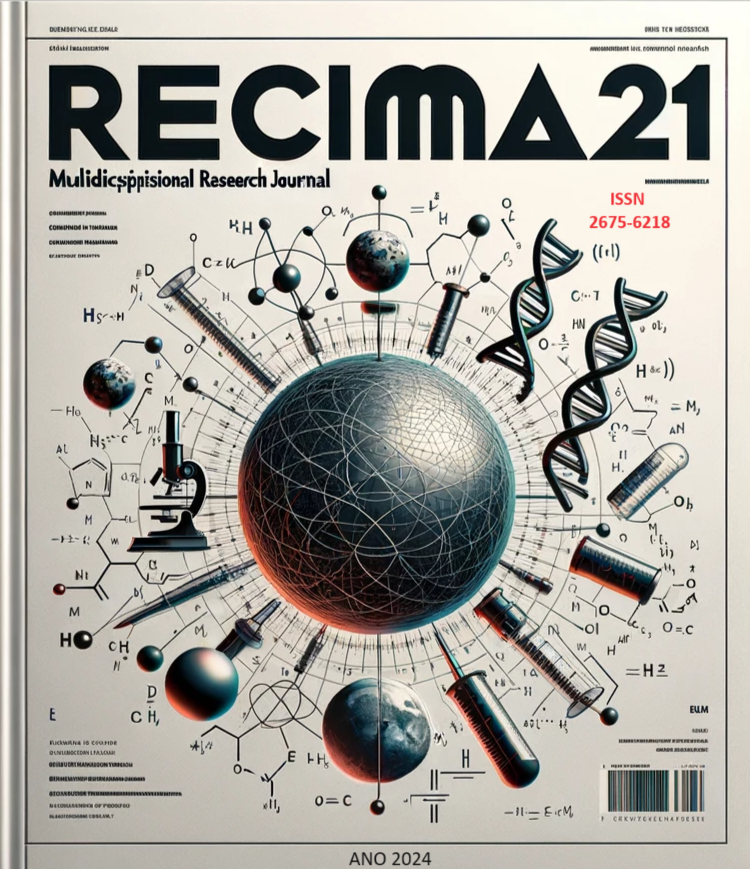RELATIONSHIP BETWEEN HYPEROXIA AND MORTALITY IN MECHANICALLY VENTILATED ADULTS
DOI:
https://doi.org/10.47820/recima21.v5i8.5473Keywords:
Oxygen. Hyperoxia. Oxygen. Critical Patient.Abstract
The aim of this study was to evaluate the relationship between hyperoxia and mortality in adults on mechanical ventilation. Methods: Articles were included in electronic databases: Pubmed, SciElo and MedLine. originals indexed in Portuguese and English, in the period between January 1, 2012 and December 31, 2022. Randomized controlled trials, retrospective and prospective cohorts that evaluated the relationship between oxygen therapy and clinical outcomes such as mortality in critically ill patients were selected. Results: The analyzed studies presented divergent results regarding the ideal concentration of oxygen to be administered in critically ill patients, with evidence supporting the hypothesis that supplemental oxygen administration may be beneficial, as well as evidence showing that excess oxygen may be harmful. Most studies point to the need for individualized treatment based on oxygen saturation monitoring and clinical evaluation of the patient. Conclusion: Although there is divergence of results in the literature, it is consensus that oxygen administration in critically ill patients should be individualized and based on clinical evaluation and oxygen saturation monitoring. The hypothesis that supplemental oxygen administration may be harmful is plausible, and the definition of the ideal concentration should be done with caution. There is a need for better designed and larger sample studies to more precisely define the impact of oxygen therapy in critically ill patients.
Downloads
References
ALMEIDA, T. DE; MENDES, B.; BRUNO, P. et al. Adjustment of oxygen use by means of pulse oximetry: an important tool for patient safety. Einstein, v. 8, p. 449–55, 2010. DOI: https://doi.org/10.1590/s1679-45082010ao1377
BÄCKLUND, M.; KEUS, F.; LAAKE, J. H. et al. Lower or Higher Oxygenation Targets for Acute Hypoxemic Respiratory Failure. The New England Journal of Medicine, v. 25, n. 1, p. 1301–11, 2021.
BELLANI, G.; LAFFEY, J. G.; PHAM, T. et al. Epidemiology, Patterns of Care, and Mortality for Patients With Acute Respiratory Distress Syndrome in Intensive Care Units in 50 Countries. JAMA, v. 315, n. 8, p. 788–800, 2016. DOI: https://doi.org/10.1001/jama.2016.0291
CRISTINA, K.; BRANDÃO, G.; FAGUNDES, L. Ventilação mecânica. VITALLE, Revista de Ciências da Saúde, v. 1, p. 173–84, 2020. DOI: https://doi.org/10.14295/vittalle.v33i1.11579
GELISSEN, H.; GROOTH, H.-J. DE; SMULDERS, Y. et al. Effect of Low-Normal vs High-Normal Oxygenation Targets on Organ Dysfunction in Critically Ill Patients: A Randomized Clinical Trial. JAMA, v. 326, n. 10, p. 940–8, 2021. DOI: https://doi.org/10.1001/jama.2021.13011
GIRARDIS, M.; BUSANI, S.; DAMIANI, E. et al. Effect of Conservative vs Conventional Oxygen Therapy on Mortality Among Patients in an Intensive Care Unit: The Oxygen-ICU Randomized Clinical Trial. JAMA, v. 316, n. 15, p. 1583-9, 2016. DOI: https://doi.org/10.1001/jama.2016.11993
GRASIELA, C.; OLIVEIRA, S. DE. Hipotermia terapêutica em pacientes pós-parada cardiorrespiratória: mecanismos de ação e desenvolvimento de protocolo assistencial. Revista Brasileira de Terapia Intensiva, v. 22, n. 2, p. 203-18, 1980.
KALLET, R. H.; FAARC, R. R. T.; BRANSON, R. D.; FAARC, R. R. T. Should Oxygen Therapy Be Tightly Regulated to Minimize Hyperoxia in Critically Ill Patients? Respitory Care, v. 61, n. 6, p. 801-17, 2016. DOI: https://doi.org/10.4187/respcare.04933
KIM, T. Y.; KIM, D. H.; KIM, S. C. et al. Impact of early hyperoxia on 28-day in- hospital mortality in patients with myocardial injury. PLOS One, v. 55, n. 8, p. 1-16, 2018. DOI: https://doi.org/10.1371/journal.pone.0201286
KNAUS, W. A.; DRAPER, E. A.; WAGNER, D. P.; ZIMMERMAN, J. E. APACHE II: a severity of disease classification system. Critical Care Medicine, v. 13, n. 10, p. 818–29, 1985. DOI: https://doi.org/10.1097/00003246-198510000-00009
NI, Y.; WANG, Y.; LIANG, B.; LIANG, Z. The effect of hyperoxia on mortality in critically ill patients: a systematic review and meta analysis. BMC Pulmonary Medicine, v. 19, n. 53, p. 1-11, 2019. DOI: https://doi.org/10.1186/s12890-019-0810-1
PAGE, D.; ABLORDEPPEY, E.; WESSMAN, B. T. et al. Emergency department hyperoxia is associated with increased mortality in mechanically ventilated patients: a cohort study. Critical Care (London, England), v. 22, n. 1, p. 9-16, 2018. DOI: https://doi.org/10.1186/s13054-017-1926-4
PANNU, S. R. Too Much Oxygen: Hyperoxia and Oxygen Management in Mechanically Ventilated Patients. Semin Respir Crit Care Med, v. 37, n. 01, p. 16–22, 2016. DOI: https://doi.org/10.1055/s-0035-1570359
PANWAR, R.; HARDIE, M.; BELLOMO, R.; EASTWOOD, G. M.; YOUNG, P. J. Conservative versus Liberal Oxygenation Targets for Mechanically Ventilated Patients. American Journal of Respiratory and Critical Care Medicine, v. 193, n. 1, p. 43–51, 2016. DOI: https://doi.org/10.1164/rccm.201505-1019OC
RUSSELL, D. W.; JANZ, D. R.; EMERSON, W. L. et al. Early exposure to hyperoxia and mortality in critically ill patients with severe traumatic injuries. BMC Pulmonary Medicine, v. 17, n. 29, p. 1–7, 2017. DOI: https://doi.org/10.1186/s12890-017-0370-1
SCHJØRRING, O. L.; KLITGAARD, T. L.; PERNER, A. et al. Lower or Higher Oxygenation Targets for Acute Hypoxemic Respiratory Failure. The New England Journal of Medicine, v. 384, n. 14, p. 1301-11, 2021.
SHAEFI, S.; BRENNER, S. K.; GUPTA, S. et al. Extracorporeal membrane oxygenation in patients with severe respiratory failure from COVID ‑ 19. Intensive Care Med, v. 47, n. 1, p. 208–21, 2021. DOI: https://doi.org/10.1007/s00134-020-06331-9
SOUZA, K. DE; CÓRDOVA, P. A.; CARVALHO, J. C. DE. Adequações dos dispositivos de oxigenoterapia em enfermaria hospitalar avaliadas por oximetria de pulso e gasometria arterial. ASSOBRAFIR Ciência, v. 5, n. 1, p. 53–64, 2014.
Downloads
Published
How to Cite
License
Copyright (c) 2024 RECIMA21 - Revista Científica Multidisciplinar - ISSN 2675-6218

This work is licensed under a Creative Commons Attribution 4.0 International License.
Os direitos autorais dos artigos/resenhas/TCCs publicados pertecem à revista RECIMA21, e seguem o padrão Creative Commons (CC BY 4.0), permitindo a cópia ou reprodução, desde que cite a fonte e respeite os direitos dos autores e contenham menção aos mesmos nos créditos. Toda e qualquer obra publicada na revista, seu conteúdo é de responsabilidade dos autores, cabendo a RECIMA21 apenas ser o veículo de divulgação, seguindo os padrões nacionais e internacionais de publicação.


 Clique para ver detalhes
Clique para ver detalhes 









